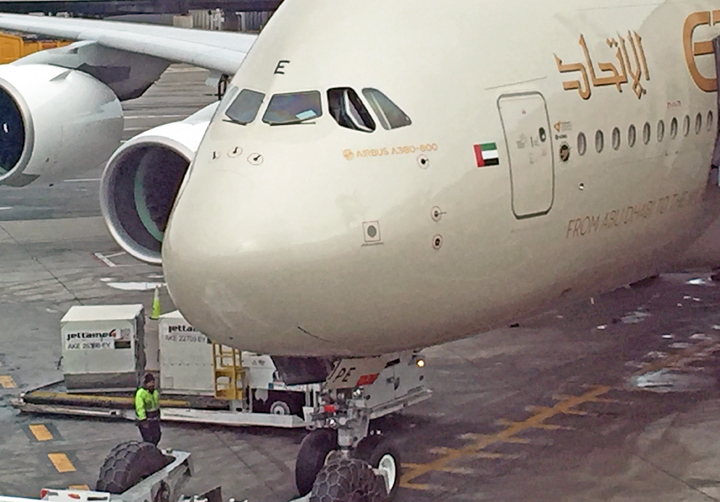Q&A With the Pilot, Volume 3

AN OLD-TIMEY QUESTIONS AND ANSWERS SESSION.
Eons ago, in 2002, a column called Ask the Pilot, hosted by yours truly, started running in the online magazine Salon, in which I fielded reader-submitted questions about air travel. It’s a good idea, I think, to touch back now and then on the format that got this venerable enterprise started. It’s Ask the Pilot classic, if you will.
Expect more of these Q&As in the coming months, if for no other reason than I enjoy putting them together. They’re geeky, but they’re fun. And I’ll never run out of fodder. It’s the nature of the business, I suppose: commercial flying is vastly misunderstood, and one of those things that everybody has a question about.
That’s good for business, but it’s frustrating as well, because much of what the public presumes about commercial flying is based on bad information. If there’s a Golden Rule to this gig, it’s this: never, ever, underestimate the traveling public’s disdain for the airlines and its willingness to believe almost every false rumor, exaggerated story and conspiracy theory. I receive many emails beginning with the words “Is it true that…” and inevitably it’s my duty to politely informing the reader that the answer is no.
Q: Is it true that jetliners have windshield wipers?
No.
I mean, yes. This might strike you as quaint, but most airliners are indeed equipped with wipers. They’re used on the ground, and during takeoff takeoffs and landings if precipitation is heavy. They are effective at keeping the windscreen clear, but tend to be very noisy. Often there’s a speed restrictions (around 200 knots, give or take), above which they should not be turned on. Some planes use a system that instead blows engine bleed air across the glass. Cockpit windows are also electrically heated to prevent ice and frost accretion. The individual panels use separate circuits and heating elements so that a failure will affect only one section. Heating also increases flexibility, providing extra protection against bird strikes.
The glass is unbelievably strong — bank-teller thick and bolstered by high-strength frames. Somewhere on YouTube is a video of maintenance workers attempting — and failing — to shatter a discarded cockpit windscreen with a sledgehammer.
If that all sounds expensive, it is. Swapping out a single cockpit pane can run tens of thousands of dollars.
Q: I was on a flight to Madrid, and about halfway through the captain said we needed to make an emergency landing because of a crack in the cockpit windshield. A short while later he told us that because we’d descended to a suitable altitude, we could proceed to Madrid as planned. I would think that with a crack in the windshield you’d want the plane on the ground ASAP.
Strong as they are, aircraft windscreens occasionally do crack. In all but the rarest cases, however, cracking will not cause a shattering or rupture of the window. How to deal with the crack depends on its size, the location, and how many layers of the glass are affected (there are multiple layers). The checklist might call for a speed reduction, and/or depressurizing in order to reduce stress on the glass. Or it might call for nothing at all.
Depressurizing requires a descent to no higher than 10,000 feet. Once at the appropriate height and speed, and so long as fuel allows, it may be possible to continue flying without further trouble.
This is the kind of thing that the crew would coordinate with maintenance personnel. Ultimately it’s the captain’s decision, but dealing with malfunctions is often a team effort between the pilots and staff on the ground, with whom we communicate via datalink or radio.
Q: We were sitting at the gate, preparing to board a flight to San Francisco. The plane was a 757. I was amazed when I looked out and suddenly saw one of the pilots with his arm hanging out the cockpit window!
Another peculiarity of cockpit windows is that some of them can be opened when the plane is on the ground. It’s normally the side windows — never those in the front — that have this capability, and only on some aircraft. The 757s and 767s that I fly are two of those aircraft. It gets hot in the cockpit with all of the lights on and electrical equipment humming, and I often crank a window open for fresh air.
The apparatus that does the latching and sliding is strictly mechanical, and also allows the window to be used as an emergency exit. It’s a long way down, so an escape rope is usually tucked into an adjacent sidewall or ceiling panel. (When commandos stormed a hijacked Air France flight in Algeria in 1995, the first officer fractured an elbow and thigh after leaping 16 feet from the cockpit of an Airbus A300.) The window fits into the frame much like a plug, and similar to how an aircraft’s doors cannot be opened during flight, neither can its windows, so long as the plane remains pressurized.
While all that glass makes for a splendid view and the chance for some fresh air, it also has a downside. Namely, noise. Going nose first into 600 miles-an-hour of onrushing air produces an exceptional racket. Ambient cockpit noise levels average about 75 decibels. Over the course of a multi-hour flight, that induces fatigue. Over the course of a career, it induces hearing loss. Engineers have tinkered with active noise reduction technology and better insulation, but the easiest way of dealing with the problem is either with a noise reducing headset or, more routinely, a pair of foam earplugs.

An A380 with open cockpit window. Photo by the author.
Q: It has always puzzled me why airliners deploy their landing gear so long before landing, yet tuck it away almost immediately after lifting off. Dropping the wheels so soon must cause a lot of extra drag and fuel burn.Sometimes that drag is helpful. Dropping the gear can be a useful tool when air traffic control sets you up too high or needs you down in a hurry. This causes a racket, however, and isn’t the most graceful way of descending or decelerating.
Normally we deploy the landing gear at somewhere around 2,000 feet on final approach. Mainly it’s just to be certain that everything is steady and stable at a reasonably early point. Lowering the gear has a significant aerodynamic impact — mainly in the adding of wind resistance, i.e. drag — thus requiring power and pitch adjustments to maintain speed, altitude, or rate of descent. It’s best to have that out of the way early on to help establish what pilots call a “stabilized approach.” Deploying the gear close-in to the runway could cause a sudden shift in airspeed and attitude exactly when it’s critical not to have a sudden shift in airspeed and attitude.
On takeoff, however, this works to a plane’s advantage. Remember, the moments just after liftoff are the most critical moments of any flight. The plane is making the transition from ground to air, and margins are relatively thin. The more help it can get — such as eliminating the drag caused by dangling struts, tires and doors — the better. On approach, by contrast, flight is well established and the margins much fatter.
All planes have maximum speeds for deployment and retraction. Airstream stress is more of an issue for the doors than for the gear assembly itself. For this reason, some of the doors will open as the gear comes down, then close up again.
Q: Whenever I have a window seat, I watch for the deployment of the wing flaps, especially during takeoffs. There have been crashes because pilots “forgot” to extend the flaps. Can you explain the process involved with the flaps?
Flaps help a wing generate lift at low speeds. Commercial aircraft will take off with the flaps extended to some intermediate position. The specific position, calculated prior to departure, depends on weight and runway length. On planes that are so equipped, leading-edge slats will also be deployed. These droop down from the forward part of the wing, and provide the same function as flaps. Flaps and slats work in concert, and are extended or retracted using the same control lever. In other words, moving the lever to a certain position will adjust both surfaces.
(On the 767 that I fly, setting the flap lever to position 1 drops the slats to the so-called midrange position while the flaps remain up. Moving the lever further, to the 5 position, which is the one most commonly used for takeoff, the slats remain in the midrange setting but the flaps extend slightly. On landing, setting the flaps to positions 15 through 30 moves the slats all the way down, while the flaps extend even further.)
Flap position is verified, re-verified, and verified again prior to takeoff. At my carrier, our checklists include no fewer than three challenge-and-response calls before reaching the runway. On top of that, commercial planes are equipped with a warning sensor that sounds an alarm if the flaps are not deployed at the moment thrust is advanced for takeoff. When using the checklists, we verify not only the flap handle position, but the indicator gauge also, to make sure the flaps’ actual position agrees with the commanded position. If or some strange reason they don’t agree, and for some strange reason we missed this, a separate warning system is triggered.
So, how it is that planes have crashed on takeoff because flaps weren’t properly set? I can think of three cases when this did indeed happened. In all three it was due to a combination of unusual circumstances: The pilots were rushed and neglected to verify position, and, for reasons that investigators could not decipher, there was a simultaneous failure of the warning system. Nowadays, however, improved checklist discipline makes a repeat of this type of accident extraordinarily unlikely.
Flaps and slats are very important during landing as well, but there’s more wiggle room here. Should they fail to deploy, either partially or at all, we can adjust by using a faster approach speed. This, in turn, affects landing distance, braking, and so on, sometimes to the point where a plane will need to divert to a longer runway. “No-flap landings” are a common simulator exercise.
EMAIL YOUR QUESTIONS TO patricksmith@askthepilot.com
Related Stories:
Q&A WITH THE PILOT, Volume 1
Q&A WITH THE PILOT, Volume 2
Q&A WITH THE PILOT, Volume 3
Q&A WITH THE PILOT, Volume 4
Q&A WITH THE PILOT, Volume 5
Q&A WITH THE PILOT, Volume 6
Q&A WITH THE PILOT, COVID EDITION
Portions of this post appeared previously in the magazine Salon.




